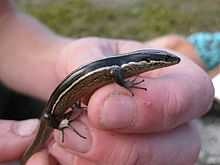Moko skink
| Moko skink | |
|---|---|
 | |
| Scientific classification | |
| Kingdom: | Animalia |
| Phylum: | Chordata |
| Class: | Reptilia |
| Order: | Squamata |
| Family: | Scincidae |
| Genus: | Oligosoma |
| Species: | O. moco |
| Binomial name | |
| Oligosoma moco | |
The Moko skink, Oligosoma moco (also known as Leiolopisma moco[1]), is a species of skink in the family Scincidae. It is endemic to New Zealand and is now found throughout the northeastern part of the North Island.[2] It's colour and pattern are variable, but its overall colour is coppery or olive brown and it usually has an even edged dark brown stripe along the side, bordered cream or white on the top and bottom. It has distinctive long toes and tail and grows to a maximum of 18 cms.
Being diurnal, moko skinks are active mainly by day, often seen basking, or found under logs and stones and in clay banks. They eat small insects, spiders and similar invertebrates.
Like most of the New Zealand native skinks, the moko skink does not lay eggs, but gives birth to live young. This appears to be an adaptation to living in a cool climate, where life is marginal for reptiles. Litters of up to eight are born around February.

References
- ↑ Patterson G, Daugherty C (1995). "Reinstatement of the genus Oligosoma (Reptilia: Lacertilia: Scincidae)". Journal of the Royal Society of New Zealand 25 (3).
- ↑ Hare KM, Daugherty CH, Chapple DG (2008). "Comparative phylogeography of three skink species (Oligosoma moco, O. smithi, O. suteri; Reptilia: Scincidae) in northeastern New Zealand.". Mol Phylogenet Evol 46 (1): 303–15. doi:10.1016/j.ympev.2007.08.012. PMID 17911035.